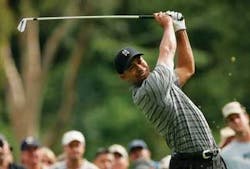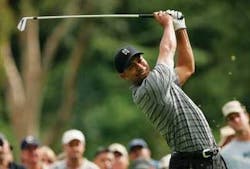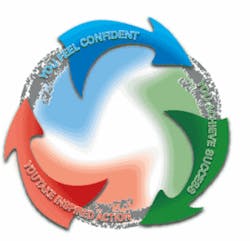Tiger Traits
by Nate Booth, DDS
Nine lessons all dental professionals can learn from Tiger Woods
Sometimes, genius shows up early. When Tiger Woods was 10 months old, he was watching his dad, Earl, hit golf balls from a mat into a net that Earl had set up in the garage. Tiger climbed down from his high chair, grabbed a small golf club his dad made for him, placed a ball on the mat, looked at the target, and then executed an exact mirror image of Earl’s swing. With his swing, Tiger smacked the ball perfectly into the net.
“I was flabbergasted!” Earl said later. “I almost fell off my chair. It was the most frightening thing I had ever seen!”
At first, Tiger hit the ball like left-handers do. After all, he watched his dad swing right-handed, and simply executed a mirror-image of the swing. Two weeks after his dramatic first shot, his dad put him on the other side of the ball. Tiger immediately reversed his grip on the club and, without missing a beat, hit the ball squarely from the right-handed position.
From this auspicious beginning in his dad’s garage at the age of 10 months, Tiger Woods could well be on his way to becoming the greatest golfer of all time. As of Oct. 10, 2006, Tiger had won 54 Professional Golf Association Tour events, including six in a row. He is the youngest player to win all four of the tour’s major tournaments (the Masters, U.S. Open, British Open and PGA) and the only golfer to be the reigning champion in all four Majors at the same time. In 2006, it was estimated that he would earn almost $100 million in prize money, appearance fees, and product endorsements.
More important than his golf accomplishments, however, is the kind of person and role model that he has become. Tiger is both a superlative professional golfer and an extremely successful businessperson. Since he was 20 years old, he has been the head of a multimillion-dollar sports empire. Tiger signed his first deal with Nike for $50 million just after his third U.S. Amateur victory. This occurred before he won his first professional tournament. The Tiger Woods Foundation that he established in 1996 helps thousands of children to reach their highest potential. Today, Tiger is well on the way to being recognized as the greatest golfer of all time, the first sports billionaire, and an exceptional philanthropist - all at the age of 30!
The Nine Tiger Trait Lessons
Tiger’s success in golf - and life - is no accident. There’s no doubt that he was born with a special talent when it comes to golf. But he also possesses nine traits that have allowed him to express that talent in record-setting ways. The American Heritage Dictionary defines a trait as “a characteristic, especially one that distinguishes an individual from another.” I believe that you can study a person’s traits and learn valuable lessons from each one. In the same way that these nine traits have made Tiger a champion, the lessons they teach can provide people with a solid foundation for an outstanding dental practice and a fulfilling life.
The nine Tiger Traits are:
- Identify and develop natural talents
- Create a clear and compelling dream
- Select teachers, heroes, and teammates who guide, inspire, and support
- Be confident
- Manufacture magnificent mental models
- Let actions do the talking
- Constantly improve in good times and bad
- Be likeable
- Be Grateful, give back
In this issue of Dental Economics®, I will present the first four Tiger Traits. Next month you will learn the final five.
TIGER TRAIT #1: Identify and Develop Natural Talents
Tiger ignored the toys that most toddlers choose. For hours on end, he preferred hitting a tennis ball “golf style” with a vacuum hose around the house. When he was 18 months old, his dad let him play his first hole on a real golf course. Tiger proceeded to shoot an 11 on a 410-yard, par 4 hole. As a 2-year-old, Tiger entered a tournament for boys ages 10 and under - and won. At age 3, he broke 50 for the first time by shooting a 48 for nine holes. He had his first hole-in-one at the tender age of six. In fact, he recorded not just one but two aces!
I believe we are born with a unique set of talents and weaknesses. Our talents are the activities in which we naturally shine, while our weaknesses are those activities in which we are challenged. It is easy to see that Tiger Woods’ talent is playing golf. This talent was identified at an early age and developed with years of training and practice. This has allowed Tiger to develop his talent to its full extent. If the talent had not been identified or developed, no one probably ever would have heard of Tiger Woods.
Traditional thinking says that if you want to excel, don’t waste time on improving your talents. Rather invest time into improving your weak areas. In this case, traditional thinking is wrong. In a book, co-authors Clifton and Nelson describe a study on the effectiveness of speed-reading courses. More than 1,000 students at the University of Nebraska were evaluated and placed into one of two groups - slow readers or fast readers. Both groups then took a speed-reading course. The slow readers went from an average of reading 90 words per minute - before the course - to an average of 150 words per minute after the course. This is a respectable 67 percent increase. To the amazement of the researchers, the fast readers went from an average of reading 350 words per minute - before the course - to an average of more than 2,900 words per minute after the course. This is a 728 percent increase! The moral: Talents do require attention to reach their maximum potential.
When it comes to talents, the bottom line is this: Discover what you do best and enjoy the most, then do more of it. In your dental practice, discover what your people do best and enjoy the most, then allow them to do more of it. When possible, either stop doing or delegate your weaknesses to others.
TIGER TRAIT #2: Create a Clear and Compelling Dream
Tiger Woods has a simple and compelling dream. He wants to be the greatest golfer of all time, and to positively affect millions of lives. Tiger has said, “Not everyone has the opportunity to affect a lot of lives in the positive way I do.” That’s a nice combination because there is something in Tiger’s dream for himself and others. What is your dream practice? It’s vital that you create a clear and compelling dream because moving harder and faster down the wrong path gets you where you really don’t want to go quicker.
In the case of creating the practice of your dreams, you must influence your team to buy into your dream. But this begins with you. In order to influence other people, you must be influenced first. This is why having a crystal-clear and compelling dream is so important. The emotion that is generated every time you think of your dream will flow into your words and body language. Your dental team will then say, “This person really believes in what he or she is talking about! He or she is going to make it happen. I want to be on the bandwagon.”
Sit down with your staff and, in as convincing a manner as possible, convey the following:
- Tell them exactly what your dream is
- Explain why the dream is so important to you.
- Tell them what’s in it for them. How will they benefit? How will helping you achieve your dream move them closer to their dreams?
- Tell them what you expect from them.
- Outline a simple plan for the achievement of the dream.
- Issue a call to action.
TIGER TRAIT #3: Select Teachers, Heroes, and Teammates Who Guide, Inspire, and Support
To date, the most memorable chapter in the Tiger Woods book started on Sunday, April 13, 1997, at 2:50 p.m. on the first tee of the Augusta National Golf Club in Augusta, Ga. The millions of viewers watching the live broadcast made this Masters the most watched golfing event in history. Thousands lined the first tee, fairway, and green. Among them were Tida and Earl Woods.
As Tiger teed off on the first hole, he was also teeing off what would become a new era for golf - an era with more people of all races, economic backgrounds, and ages. For the moment, Tiger Woods was a symbol of the dreams of other people. In his mind, he had imagined winning the Masters hundreds of times. He was about to see if he could win it for real on his first attempt.
Even though Tiger was standing on that first tee by himself that day, there were millions of people who were beside him in spirit. The most notable of these were Tiger’s teachers, heroes, and teammates - the people who had helped him become the person on the center stage that day.
Tiger’s greatest teachers and heroes are his parents, Earl and Tida. As a young man on duty in Bangkok, Thailand, Earl met a pretty young woman named Tida who worked as a secretary in the Army office. They fell in love, moved to the U.S., and were married in Brooklyn, N.Y., in 1969. After Earl accepted a position at McDonnell Douglas in 1975, they relocated to Cypress, Calif. Then, on Dec. 30, 1975, a baby boy, Eldrick, was born to the couple.
Because of Earl’s modest income and the couple’s decision to have Tida stay home with their son, whom they nicknamed Tiger (he never had a baby-sitter), Tida and Earl didn’t take a vacation for more than 20 years. They spent between $25,000 and $30,000 a year to enter Tiger in national tournaments and travel with him.
While Earl and Tida were not rich in monetary terms, they were rich in more important areas. These included the ideals, beliefs, and standards that they held dear. They instilled these building blocks of success in Tiger so that he could become the person he is today.
The 1997 Masters Tournament
A minute ago, we left Tiger as he was standing on the first tee of the Augusta National Golf Club. On the front nine of the opening round, he shot a very “un-Tiger-like” four-over par 40. On the back nine, he righted the ship with a six-under par 30. That gave him a round of 70 for the day. This score put him in fourth place, three strokes behind the leader.
On the second day, Tiger shot the day’s best round, a 66. This gave him a three-stroke lead at the halfway point of the tournament. On day three, Tiger had 11 pars and seven birdies for a round of 65, stretching his lead to nine strokes.
For the final round, with 15.3 million homes watching on television, Tiger shot a 69. His 18-under par score of 270 for the tournament was a record, as was his 12-stroke margin victory. At age 21, he became the youngest player to win the Masters. In addition, he was the first person of color to win a PGA Major.
After he sank his four-foot par putt on the final hole, with the TV cameras following his every move, Tiger embraced the two most important people in his life - his mom and dad. President Bill Clinton called him later in the evening and told Tiger the embrace was the best shot he saw on television that day.
One of the great traditions in sports is the awarding of the green jacket to the winner of the Masters. Tiger Woods wore his jacket proudly at the champion’s dinner that night. He was wearing it for himself, his parents, teachers, heroes, and the millions of people who believed in him. Later that evening, in a house Tiger had rented while competing at the Masters, Tida Woods noticed her son was missing. She went to an upstairs bedroom and found Tiger fast asleep. He was clutching his green jacket like it was a teddy bear!
In dentistry, who are your teachers, heroes, and teammates? Who guides, inspires, and supports you? Choose these people wisely. They will have a major impact on your success.
TIGER TRAIT #4: Be Confident
From the beginning, Tiger had a simple goal for each tournament - to win. Tiger’s confidence is not an accident. It is the culmination of an abundance of natural talent put into play, a dream that requires excellence to achieve, and a group of people who instruct, inspire, and help instill confidence. Through the years, Team Tiger has provided oodles of confidence-boosting instruction.
From ages 4 to 10, Tiger’s first professional teacher - Rudy Duran - established a “Tiger par” for each hole the child played. If Tiger reached a green with four perfect shots, Rudy made Tiger par for that hole a six - four to reach the green plus two putts. This kind of thinking was vital to Tiger’s success. He had something to shoot for on every hole - something he could attain with excellent execution.
From the beginning, the young golfer rarely shot over “Tiger par.” This allowed him to gain confidence at a young age. This confidence would become a trademark of Tiger’s tournament play in later years.
“In Confidence: How Winning Streaks and Losing Streaks Begin and End,” by Rosabeth Moss Kanter says, “Confidence lies at the heart of civilization. Everything about an economy, a society, an organization or a team depends on it. Every step we take, every investment we make, is based on whether we feel we can count on ourselves and others to accomplish what has been promised. Confidence determines whether our steps - individually and collectively - are tiny and tentative or big and bold.”
Confidence is the fuel that fires the self-fulfilling prophecy phenomenon. Our lives are just a constant series of “now” moments. Each “now” moment affects all future ones. If you feel confident that some event will occur in the present, it casts a positive spell for future “now” moments and increases the likelihood of their occurrence. The opposite is also true. So, success in life or business is not a single event. It is a long-term success cycle that gains momentum as it repeats. This cycle is shown in the diagram below.
LONG-TERM SUCCESS CYCLE
Tiger has always felt confident in his abilities. His parents and Team Tiger have made sure of this. This confidence has led him to take inspired action, both in terms of his practice ethic and while competing. This inspired action (coupled with his natural talent) has created success on a spectacular and regular basis.
Tiger’s success has made him even more confident, which leads to more inspired action, more success and more .... I think you get the idea. The bottom line is that Tiger does not just hope he can win. He expects to win.
Tiger’s playoff record is phenomenal. He has won 14 of 15 events that have gone past regulation. Remember, in playoffs Tiger is competing against golfers who played just as well as he did during the 72 holes of a PGA tournament. If you consider that two of his playoff meetings had three participants, there’s a one in 18,432 possibility of that happening. A record of 14-1 is no accident. It’s confidence and skill in action.
With your family, your dental team and yourself, do you create “Tiger Pars” that lead to successful action? Do you support and encourage excellent behavior? I hope so. Their confidence levels, as well as your own, depend on it.
Each Tiger Trait builds on the previous one. First, you identify and develop natural talents in others and yourself. Then you create a clear and compelling dream that harnesses the power of these talents. Next, you select teachers and heroes who will guide and inspire you on the path to your dream. Then you create the confidence that will energize the journey to your dream. Next month, I will give you the last five Tiger Traits. In the meantime, be a Tiger!The preceding was from Dr. Booth’s newest book, “Tiger Traits: 9 Success Secrets You Can Discover from Tiger Woods to Be a Business Champion.” To order an autographed copy of the book or learn how you can have the author make a Tiger Traits presentation to your group, go to www.tigertraits.com or call (800) 917-0008. Tiger Traits is an interpretation of Tiger Woods’ life example by Dr. Nate Booth. The author and the book are not affiliated with or endorsed by Tiger Woods.
Nate Booth, DDS, teaches comprehensive case acceptance at the Las Vegas Institute for Advanced Dental Studies. His in-office, video-based training program, “The ‘Yes’ System: How to Make It Easy for Patients to Accept Comprehensive Dentistry,” has helped hundreds of dentists do more big cases. Through his telephone-coaching program, Dr. Booth assists dentists in creating the practices of their dreams. For more information, call him at (800) 917-0006, or visit his Web site at www.natebooth.com.


